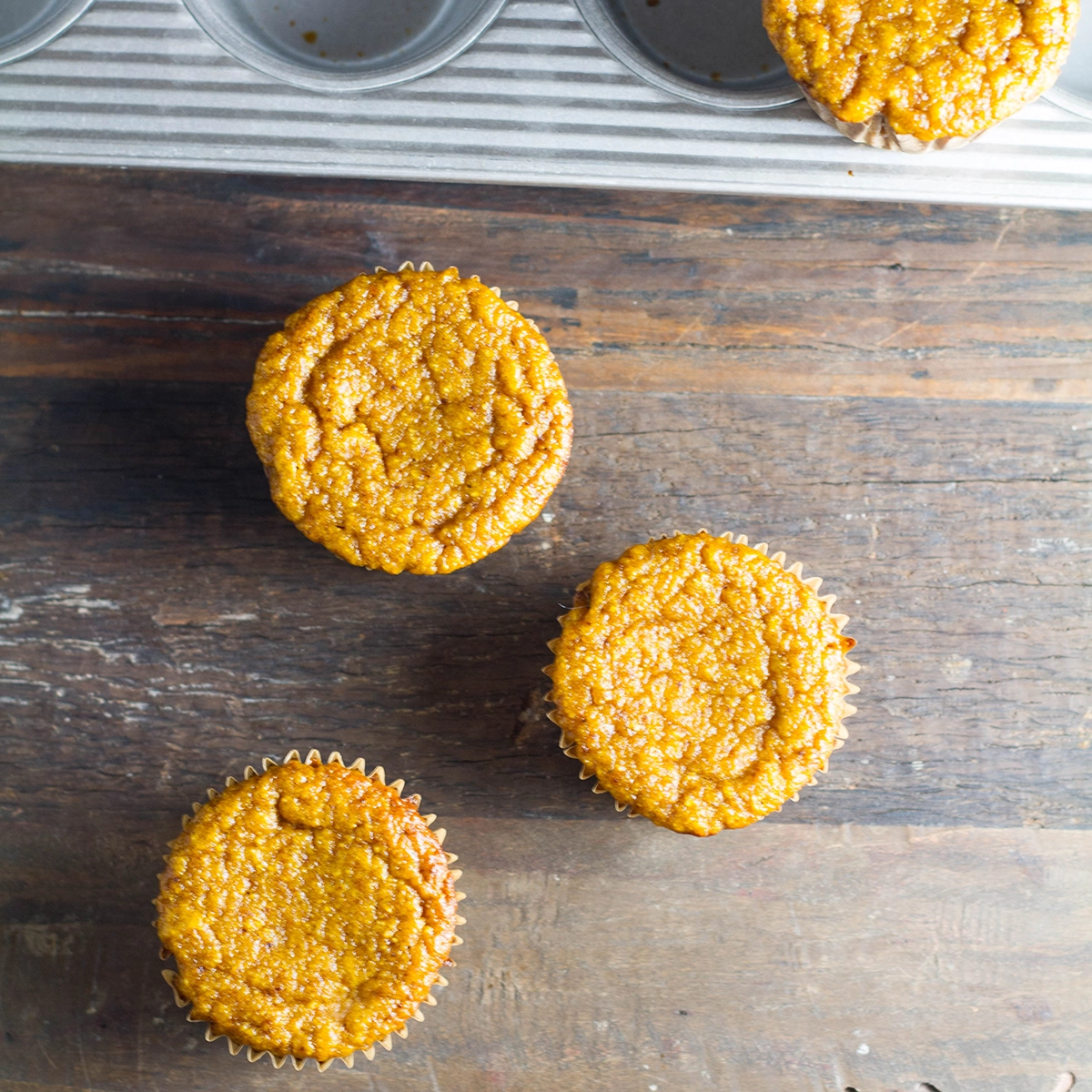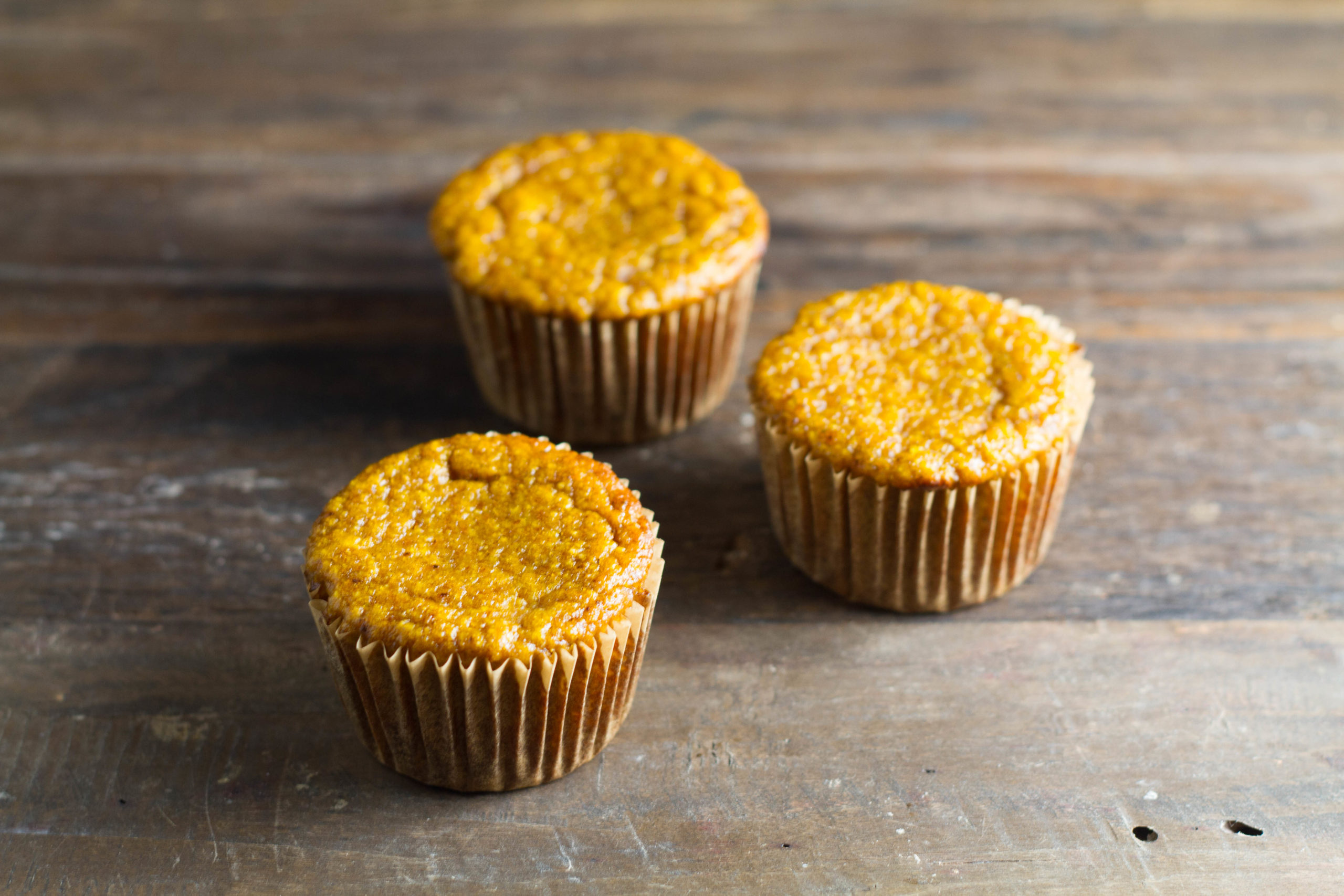
This recipe originally appeared in my cookbook, Everyday Keto Baking. In the book it calls for two tablespoons of milk. Depending on the low-carb sweetener you use, you may need a bit more moisture from a liquid ingredient in the recipe. I tested this recipe with Swerve, which is a bulk low-carb sweetener. Learn more about low-carb sweeteners on page 15 in the book.
After retesting it, I've found it can benefit from ¼ cup more milk. I also used almond yogurt, so if you're a fan of yogurt, it works well as a substitute for milk. Keep in mind, this measurement will vary a bit depending on the sweetener you use.
This pumpkin muffin boasts an array of spices, including nutmeg, ginger, cinnamon, and cloves. To make them even more festive, frost the pumpkin muffins with the Cream Cheese Frosting (page 100) or the Maple Cream Frosting (page 101) for a dairy-free option. Frost them once they've cooled.
We tested all the recipes in the book with a bulk low-carb sweetener, Swerve. If you prefer a non-bulk sweetener like Stevia or Monk Fruit, you can add about ½ cup of collagen proteins (see comments) with the sweetener instead.
I recommend storing the muffins in the refrigerator because they spoil easily when left outside at room temperature.

Pumpkin Muffins {low carb}
Ingredients
- ½ cup pumpkin purée, homemade or canned
- ½ cup low-carb 1:1 sweetener or equivalent
- 4 large eggs
- ¼ teaspoon baking soda
- ¼ teaspoon salt
- ½ teaspoon ground nutmeg
- ½ teaspoon ground cinnamon
- ½ teaspoon ground cloves
- ½ teaspoon ground ginger
- 6 tablespoons coconut flour (¼ cup plus 2 tablespoons)
- ¼ cup coconut milk or other milk or yogurt
Instructions
- Preheat your oven to 350°F (175° C, or gas mark 4).
- Prepare a muffin pan by lining the muffin wells with liners. Grease the liners unless they are nonstick liners.
- Place the purée, sweetener, and eggs in a bowl and blend well.
- Add the baking soda, salt, nutmeg, cinnamon, cloves, ginger, coconut flour, and coconut milk to the bowl and mix well. Let the batter sit for a few minutes and then mix again.
- Fill the muffin liners two-thirds full and bake for 25 minutes, or until a toothpick inserted in the center of a muffin comes out clean.
- Cool and serve. Store in a sealed container in the refrigerator for a few weeks, or in the freezer for a few months.

Joni says
the ingredients ARE listed, but putting them into the recipe (how and when) is assumed - not stated. (flour and milk)
Erica says
Thanks for catching that and letting me know! Just added them. Best wishes.
Lutrecia Macdonell says
Why is coconut flour listed twice in the recipe? Thank you!
Erica says
Thanks! Someone else just posted a message that I left out the coconut flour so I added it again, but it was already in there!
Deborah Nitzberg says
Making this now but wanted to alert you of some inconsistencies in the recipe. The coconut flour is not listed under the instructions and the ginger, listed in the instructions, is not listed in the ingredients. Also, the 1/4 milk/yogurt addition is also not listed in the instructions. Wish me luck!
Erica says
Thanks! The coconut flour is in there, in tablespoons, and I added ginger to the steps.
Libby says
If one cannot tolerate low carb sweeteners like erythritol one can get the bulk from collagen peptides (I use Vital proteins). So in this recipe I would add 1/2 cup CP to the pure monk fruit or pure stevia and it works like a charm. I’ve been using this hack since the tip was given some months ago in a comment on your blog. It truly makes all the difference in the finished product and I’m able to use the recipes in your lovely book and keep the gut happy.
Erica says
Thanks, Libby! Yes, you can use protein/collagen peptides with a sweetener like stevia or monk fruit in place of a bulk sweetener. But they can't be used by someone following SCD, so the SCD recipe using honey is the way to go if you have digestive sensitivity.
suzanne says
I have unsweetened collagen powder. How much stevia or monk would I add to that?
Erica says
You would add the equivalent amount of sweetener based on the brand of sweetener that you are using. Brands vary to some degree and my Everyday Keto Baking cookbook has a chart on page 15 that shows how much of each sweetener to use, in general.
S says
I subscribe to your blog because you create recipes that are SCD approved and good for the gut. Low carb sweetener is very hard on the gut so I’m confused by this one.
Erica says
Most of my recipes here are SCD, but this one is for the folks who purchased my Keto cookbook. The SCD version of this recipe is also on my blog and in one of my cookbooks. I try to make it easy for folks to try recipes from my cookbook before they buy it. I also label all my recipes as SCD or not.
Marina says
Have you tried rice malt syrup?
Erica says
I haven't. I'm not sure what that is.
Amanda says
How can I use almond flour in place of coconut ?
Erica says
It's not a straight conversion, it requires some adjustments which I haven't developed yet.